Ecologist Will Watson is hunting for Britain’s largest blood-sucking leech in a 14,000-year-old pond in Herefordshire. The elusive medicinal leech (Hirudo medicinalis), grows up to 20cm long and has only officially been recorded three times in the county in the past two decades. In the ice age pond in Moccas Park national nature reserve it was last found in 2000.
Watson shakes his net in the water. Most creatures shy away from such disturbance but this leech – the only one in Britain that sucks human blood – is attracted to the vibrations as they suggest the movements of large mammals trampling around the edge of the pond, which could signal a potential meal.
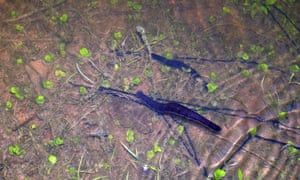
Unfortunately, the leech is not fooled this time, but we do find several water beetles, descendants of creatures alive when what is known as the Lawn Pool pond was formed. Thousands of years ago, these insects would have shared the water with woolly mammoths, aurochs and elk coming in to drink, wallow and nibble new shoots. Beavers also would have helped keep the pond open by felling trees, until about 500 years ago.
Now, with megafauna gone and farmers no longer coppicing the trees surrounding it, the pond, like many in Britain, has become overgrown. About 80% of it is shaded by willow and scrub, which reduces overall biodiversity because most pond species like light.
There are an estimated 1,500 ice age ponds in Herefordshire. With GBP252,000 from the National Lottery Heritage Fund, a project is being launched to cut away the vegetation that hides them and raise awareness about the biodiversity of these rich relics. The project is being run by three organisations – Herefordshire Wildlife Trust, Herefordshire Amphibian and Reptile Team and Herefordshire and Worcestershire Earth Heritage Trust.
“If you leave a pond it will naturally, in most cases, silt up and turn into a bog or a woodland,” says Dave Hutton, ice age ponds project officer at Herefordshire Wildlife Trust. “Without those natural processes, like aurochs and large mammals traipsing around and keeping them open, ponds and their wildlife tend to disappear. We’re acting like beavers and other large herbivores and keeping them open.”
In 2003, Watson was doing a survey of Herefordshire’s ponds when he realised something extraordinary: out of 260 ponds, nearly half were home to the great crested newt. This is probably the highest occurrence rate for the species anywhere in Britain and there was a theme – the most biologically rich ponds were all of ice age origin. Nationally, 1% of ponds were created during the ice age but in this pocket of north-west Herefordshire this figure rises to 25%.
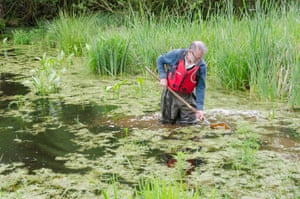
This is because, 25,000 years ago, a thick lobe of ice came from the Welsh mountains and reached what is now the A49, running between Hereford and Leominster. A few thousand years later, as the frozen mass retreated, it dumped moraine and blocks of ice in north-west Herefordshire, carving out a unique undulating landscape peppered with hollows, which then filled with water.
An unknown number of ponds – sometimes referred to as kettle hole ponds – have already disappeared, with many flattened out by farmers to extend land under cultivation.
The Lawn Pool, which is on private land owned by the Chester-Master family, looks like an ordinary pond to the untrained eye. It has a grassy edge, open water (which sometimes disappears in dry years), swamp and a little woodland. But when Watson empties out the contents of his net it becomes clear this body of water is packed with strange creatures. Last year, researchers counted 53 species of aquatic invertebrates in a single session (an average pond would yield about 20), including 32 species of water beetle.
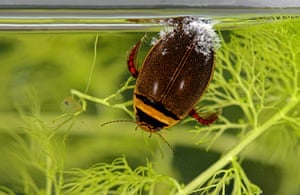
One of the most exciting finds was a 14-15mm long diving beetle (Graphoderus cinereus), which has only been found at a handful of other sites in south-east England. Another was a water scavenger beetle (Helochares obscurus), which in Hereford has only been recorded in ice age ponds. Watson says: “Inside these ponds there are glacial species that have hung on but they’re not really suited to today’s climate. There are assemblages of beetles that are more similar to beetles of 15,000 years ago.”
The Lawn Pool is also home to a carnivorous plant called bladderwort that devours water fleas and other invertebrates – the only one found in Herefordshire – and a rare aquatic plant called tubular water dropwort. Green sandpipers, little egrets and little ringed plovers are just a few bird species found feeding on the pond’s margins.
Because these ponds are so old, many species have been able to colonise them. “It’s a continuum going right back to the last ice age,” says Hutton. “What we’ve got in these ponds is that habitat continuity – there is a direct link with the past that has led to that diversity compared with the surrounding terrain which has been much more affected by man’s activities.”
Ice age ponds tend to form in clusters. In some parts of Herefordshire, there is a pond in each field. This makes it easier for species to move between them, meaning populations are more resilient to local climatic changes. Some ponds are large and deep, while smaller ones dry out each summer. Local differences mean each habitat supports slightly different species, increasing overall biodiversity.
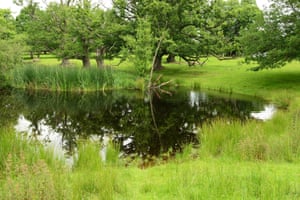
Ice age ponds are often saucer-shape (unlike man-made ponds, which usually have steep sides) and the warm, sunny, shallow areas are the most important for wildlife, supporting the majority of plants and aquatic invertebrates. Conservationists aim to clear around a third of total shading for each pond. “It’s a big opportunity because ponds haven’t been managed in the past and there’s a lot to be gained,” says Watson.
The approach has an established track record: in an ice age pond at Mere Pool at nearby Blakemere, 18 trees were removed in 2013, leading to a 30% increase in aquatic plant species and a doubling of invertebrate populations.
Agricultural run-off is also a huge problem and often causes a thin layer of duckweed to cover the surface of ponds, which blocks sunlight. The project is using Environment Agency Lidar (light detection and ranging) data to look at the contours of the land, which will help to identify the shape of river catchments and the source of potential contamination.
By knowing which farms are likely to be contaminating specific ponds, conservationists can prioritise getting those farmers into agri-environment schemes – incentivising them to farm in a more environmentally friendly ways.
The large majority of UK ponds lack protection. This matters because habitats that don’t receive proper protection deteriorate. Watson wants ice age ponds to be listed as priority habitats on the Countryside Stewardship scheme so that money can be put towards their conservation and management.
Moccas Park is a site of special scientific interest but, unlike its old oak trees, the pond is not a notified habitat within that. “In the 1980s and 90s, woodland and meadows got better protection, but ponds didn’t. We want to change that,” Watson says.
These ponds are also valuable geological time capsules, giving insight into how Herefordshire has changed over thousands of years. Pollen collected in core samples from deep pond sediment shows that after the ice retreated about 14,000 years ago, Herefordshire quickly warmed up and became covered in birch and juniper woodland. It then cooled again for a few thousand years before warming even more, as shown by the abundance of species such as oak, hazel and elm.
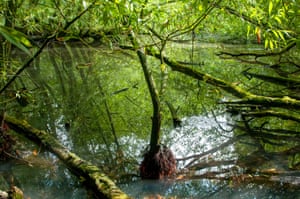
“Kettle hole ponds are very good because they start off quite deep – they can be 20 metres deep to begin with – so there is a lot of space for sediment to accumulate,” says Prof Ian Fairchild, who is chair of the Herefordshire and Worcestershire Earth Heritage Trust. “They’re a good setting in which to get records which span that period between the late glacial towards the present day.”
Herefordshire’s ancient history still is not well studied and experts involved in the restoration project hope that it will be the start of more research into the area, including the history of early humans who probably would have congregated around these ancient water holes.
The team have created an exhibition at Hereford Museum until the end of October, showing their findings. “If we make people more aware of these ponds they may be less likely to disturb sites which may be looked at in the future … it will be of lasting value as we seek to improve our environments for our descendants,” says Fairchild.
Find more age of extinction coverage here, and follow biodiversity reporters Phoebe Weston and Patrick Greenfield on Twitter for all the latest news and features